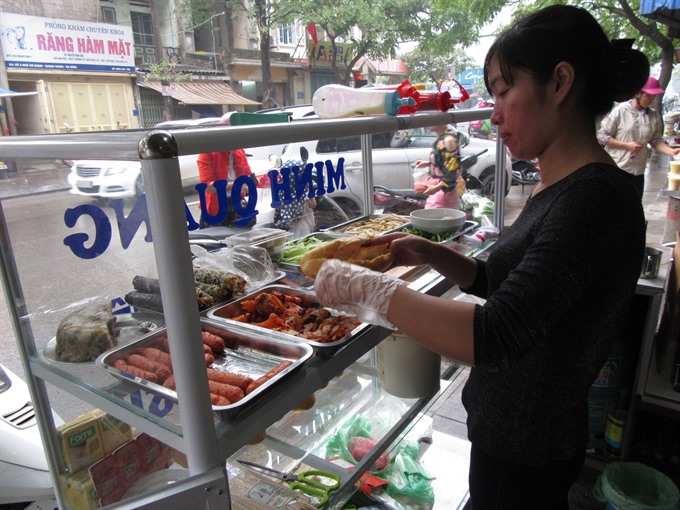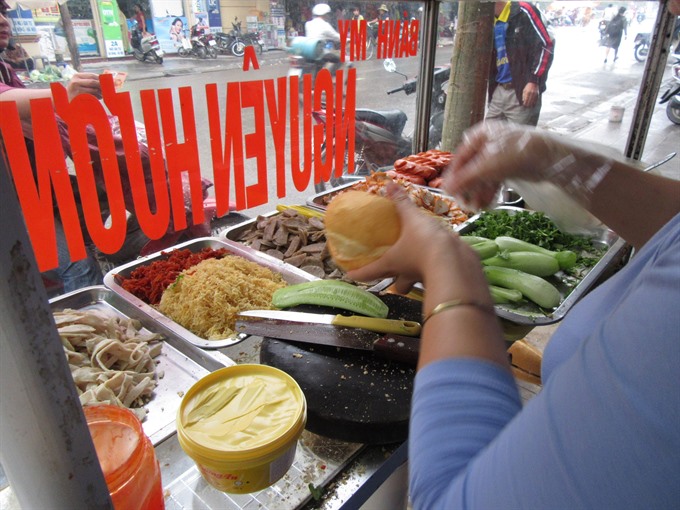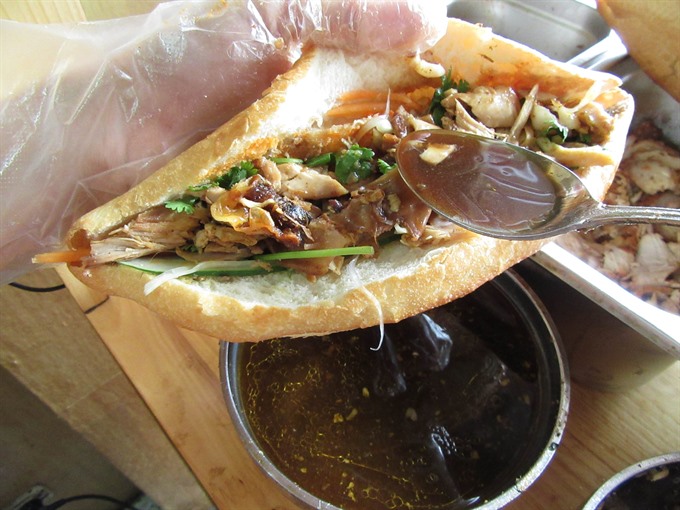 Life & Style
Life & Style

“Vietnamese sandwiches” are what foreigners sometimes call these delicious handheld meals. But for those who have visited the country, they may not forget the street food’s Vietnamese name: bánh mì.
 |
| Foreign favourite: Bánh mỳ quickly became the daily lunch choice for Spanish expat Gerard Claramont, who has lived in Hà Nội for four months.—VNS Photo Bạch Liên |
by Vương Bạch Liên
During my short stay in Paris two years ago, I was pleasantly surprised to see long lunchtime queues of French eaters waiting for Vietnamese sandwiches. Although the Vietnamese employees worked away quickly preparing the sandwiches, the volume was so high that customers had to wait their turn to dig in.
“Vietnamese sandwiches” are what foreigners sometimes call these delicious handheld meals. But for those who have visited the country, they may not forget the street food’s Vietnamese name: bánh mì. And it is fitting that bánh mì is so popular in France, given that its origins link the streets of Paris and the streets of Sài Gòn.
It turns out that one of the longest lasting influences of French rule in Vietnam was their baked goods. The baguette was introduced to Sài Gòn during the French colonial period and spread through the country’s southern cities before arriving to the North of Việt Nam and becoming popular in the whole country.
Many lovers of Vietnamese cuisine consider bánh mì an excellent example of of fusion food. The It combines ingredients from the French (baguettes, pâté, and mayonnaise ) with native Vietnamese ingredients, such as coriander, cucumber, and pickled carrots and daikon.
Not only does bánh mì exemplify fusion food; it also has become the epitome of street food. The sandwiches are sold almost exclusively from stalls and vendors.
It is a simple and cheap street food that anyone can afford, paying only from VNĐ15,000 (US$0.7) to VNĐ25,000 (US$1.1) for a sandwich.
It may be a cheap street eat, but it’s also an international foodie force. You can find the French-Vietnamese fusion dish far beyond the streets of France and Vietnam, and it has quickly become one of the ingredients to Vietnam’s culinary fame abroad. Bánh mì was listed in top 10 of the “World’s best street food” by Lonely Planet, and the word Bánh mì was added to the Oxford English Dictionary on 24 March 2011.
An article published in 2012, the Guardian said: “A little-known secret is that the world’s best sandwich isn’t found in Rome, Copenhagen or even New York City, but on the streets of Việt Nam.”
Demand rising
What can make it so special?
Stéphanie Lansaque, a French artist from Paris who has travelled many times between France and Việt Nam with her husband over the last ten years, said:“We like bánh mì a lot. The first time we ate it, it was in Paris, in the 13th district. Now, Vietnamese bánh mì has become very popular in France, in particular in Paris. More and more stalls are open,” she said.
“In French sandwiches, we normally find the salad, and the tomatoes which accompany the meat. In bánh mì, we almost always find the wrapped carrots, which are sometimes pickled, the cucumber and the coriander. This gives crunchiness and very fresh tasting. It is surely what pleases French people in bánh mì,” she said.
‘In general, French people love Vietnamese cuisine, and the bánh mì is for them an economical and rapid way to eat Vietnamese food,” she adds.
Nguyễn Thoa, owner of a bánh mì stall in Paris’s 13th district (where many Asian Parisians live) said that she recently opened a stall to sell bánh mì after seeing the raising demand of French people of this dish.
“I have many clients who keep coming back to the stall to ask for a bánh mì for their lunch, I am glad about this.”
Variations on a theme
In three different regions of Việt Nam (North, Centre and the South), bánh mì varies greatly in terms of taste. However, bánh mì made in Hà Nội style, in Hội An style or in Sài Gòn style still share lot of commonalities.
Typical fillings in bánh mì include steamed, pan-roasted or oven-roasted pork belly, Vietnamese sausage, grilled pork, pork liver pâté, grilled chicken, canned sardines in tomato sauce, soft pork meatballs in tomato sauce, head cheese, fried eggs.
Accompanying vegetables typically include fresh cucumber slices, coriander and pickled carrots. Common condiments include spicy chili sauce, sliced chilis, mayonnaise, and cheese.
Almost all of these varieties are innovations made by or introduced in Sài Gòn which then travelled to Hà Nội.
Ask the difference between bánh mì Hà Nội and bánh mì Sài Gòn? Many people who do not often eat the bánh mì in those two regions couldn’t tell you. But Thái Chung, owner of the BMK restaurant on Hà Nội’s Nguyễn Khuyến street, specialises in bánh mì Sài Gòn and other Sài Gòn specialities. He said that he often mixes fried chicken and crushed pork meatballs in different spices in a style unique to Sài Gòn. However, he prefers to keep his recipe secret.
However, it’s easier to distinguish a bánh mì Hà Nội and bánh mì Hội An. Bánh mì made in Hội An style differs from bánh mì made in Hà Nội style in the sauce, explains Trần Thị Huệ, the manager of a bánh mì Hội An shop in Trần Hưng Đạo street in Hà Nội.
“I find bánh mì Hà Nội quite dry because it has too little or no sauce at all. With bánh mì Hội An, we put lot of sauce inside the fillings. The sauce is the juice of simmered pork meat, and this brings our bánh mì a unique taste,” she said.
Bánh mì Hội An are appreciated in Hà Nội. In her shop, about 700 sandwiches are sold every day
.
Regardless of the regional style, many of the reasons to love bánh mì remain constant. The sandwich is cheap and mobile, easy to take away wrapped in recycled paper.
And once you sit down on tiny plastic stools to dig in, one can enjoy something that brings together the best flavours of two great culinary cultures, and one can do so with friends. Queen of street food, bánh mì brings cultures and people together.—VNS
In box:
Some good bánh mỳ stalls in Việt Nam
In Hà Nội
1. Bánh mỳ Phố Huế: 118 A, Huế street
2. Bánh mỳ Trâm: 30 Đình Ngang street
3. Bánh mỳ Hội An: Bami Bread: 88 Trần Hưng Đạo
4. Bánh mỳ Lãn Ông: 6 Chả Cá
5. Bánh mỳ Bà Dần: 34 Lò Sũ
In Hội An
1. Bánh mỳ Phượng: 2b Phan Chu Trinh street,
2. Bánh mỳ Phố cổ: 2 Lê Lợi
3. Bánh mỳ Lành: 430 Cửa Đại
4. Bánh mỳ thit heo quay (roasted pork) Minh Thu: 248 Lý Thường Kiệt
5. Bánh mỳ Queen (bà Khánh): 115 Trần Cao Vân
HCM City
1. Bánh mỳ Huỳnh Hoa: 26 Lê Thị Riêng street, distr 1
2. Bánh mỳ Hồng Hoa: 62 Nguyễn Văn Tráng, district 1
3. Bánh mỳ thịt nướng (grilled pork): 37 Nguyễn Trãi
4. Bành mỳ ốp la Hòa Mã: 51 Cao Thắng, district 3
5. Bánh mỳ Nguyên Sinh: 141 Trần Đình Xu, district 1
 |
| Seductive sight: Bánh mỳ attracts food-lovers in Hà Nội with it’s warm savory aroma and its eye-catching colours in itsfillings. — VNS Photo Bạch Liên |
 |
| Filled with flavour: The sandwiches are almost always made-to-order in street stalls around the country. — VNS Photo Bạch Liên |
 |
| Motorbike munchies: Stalls selling bánh mỳ Sài Gòn are found in many corners of Hà Nội.— VNS Photo Bạch Liên |
 |
| Sweet, simmering, sauce: Bánh mỳ Hội An is remarkable for its sauce made of the juice of simmered pork meat.—VNS Photo Bạch Liên |




